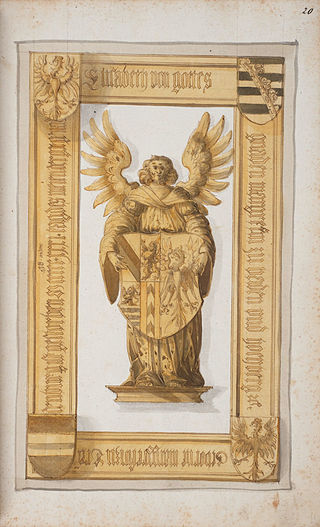Life
Kunigunde was the youngest child of the Margrave Casimir of Brandenburg-Kulmbach (1481–1527) from his marriage to Susanne (1502–1543), daughter of the Duke Albert IV of Bavaria.
She married on 10 March 1551 in Neustadt an der Aisch with Margrave Charles II of Baden-Durlach (1529–1577). Kunigunde had been raised in the Lutheran faith, while her husband belonged to the Catholic church. [1] Under the influence of his wife, Charles began to turn to the Reformation.
When an imperial ban had been pronounced over her brother Albrecht II Alcibiades in 1554, Kunigunde took him into her residence in Pforzheim, where he died in 1557, a year before her death. They were both prominent spa guests at the mineral springs of Bad Liebenzell. [2]
She died in 1558 and was buried in the St. Michael Church in Pforzheim, where a cenotaph of the margravine can be found in the choir.
Baden came via her into the possession of the precious prayer book Gebetbuch der Markgräfin von Brandenburg, which Narziss Renner had created for her mother in 1520. It is now in the Baden State Library.

Frederick I of Ansbach and Bayreuth was born at Ansbach as the eldest son of Albert III, Margrave of Brandenburg by his second wife Anna, daughter of Frederick II, Elector of Saxony. His elder half-brother was the Elector John Cicero of Brandenburg. Friedrich succeeded his father as Margrave of Ansbach in 1486 and his younger brother Siegmund as Margrave of Bayreuth in 1495.

John Frederick, Margrave of Brandenburg-Ansbach succeeded his father Albert II as margrave of Ansbach in 1667. He married his second wife Princess Eleonore Erdmuthe of Saxe-Eisenach on 4 November 1681. Their daughter Wilhelmine Charlotte Caroline, Margravine of Brandenburg-Ansbach married George II of Great Britain before he became king.

Casimirof Brandenburg-Bayreuth was Margrave of Bayreuth or Margrave of Brandenburg-Kulmbach from 1515 to 1527.

Susanna of Bavaria was a German noblewoman. Born in Munich, she was the daughter of Albert IV, Duke of Bavaria, and Kunigunde of Austria, herself the daughter of Holy Roman Emperor Frederick III and Eleanor of Portugal. Her paternal grandparents were Albert III, Duke of Bavaria, and Anna of Brunswick-Grubenhagen-Einbeck.

Charles II, Margrave of Baden-Durlach, nicknamed Charles with the bag, governed the Margravate of Baden-Durlach from 1552 to 1577. On 1 June 1556 Charles issued a new Church Order, which made Lutheranism the official religion in Baden-Durlach.
The Second Margrave War was a conflict in the Holy Roman Empire between 1552 and 1555. Instigated by Albert Alcibiades, Margrave of Brandenburg-Kulmbach and Brandenburg-Bayreuth, who was attempting to form a Duchy of Franconia under his rule, the war resulted in widespread devastation in Franconia, while also affecting the Rhineland and Lower Saxony.

Sophia of Poland, was a Polish princess, member of the Jagiellonian dynasty, great-granddaughter of Emperor Sigismund and by marriage Margravine of Brandenburg-Ansbach and Brandenburg-Kulmbach.

Marie of Brandenburg-Kulmbach was a Princess of Brandenburg-Kulmbach and by marriage Electress Palatine.

Countess Palatine Christina Magdalena of Kleeburg of the House of Wittelsbach, Margravine of Baden-Durlach, was a Swedish princess, daughter of John Casimir, Count Palatine of Kleeburg and Princess Catherine of Sweden. Christina Magdalena belonged to Swedish royalty as a sister of King Charles X of Sweden, and grew up in Sweden.

Magdalena Wilhelmine of Württemberg was a margravine of Baden. She had a place in the regency during the minority of her grandson in 1738-42.

Emilie of Saxony was Margravine of Brandenburg-Ansbach as the third wife of Margrave George the Pious of Brandenburg-Ansbach. Since his two earlier wives died before his accession, she was the only one to hold the title of Margravine.
Margaret of Baden was a Margravine of Baden by birth and by marriage Margravine of Brandenburg-Ansbach and Brandenburg-Kulmbach. She was the daughter of Jacob, Margrave of Baden-Baden, and his wife Catherine of Lorraine.
Elisabeth of Brandenburg may refer to:

Margrave Ernest I of Baden-Durlach was the founder of the so-called "Ernestine" line of the House of Baden, the line from which the later Grand Dukes descended. He was the ruling Margrave of Baden-Pforzheim from 1533 and resided in Pforzheim from 1537. In 1565, his son Charles II moved the capital to Durlach and thereby changed the name of his country to Baden-Durlach. He had to deal with the upcoming Reformation and the frequent Ottoman wars in Europe. In this turbulent time, he tried to maintain a neutral position between the Protestants and Catholics. He did not participate in the Schmalkaldic War.

Bernard IV, Margrave of Baden-Durlach was Margrave of Baden-Pforzheim from 26 September 1552 until his death.

Countess Palatine Anna of Veldenz was Margravine of Baden-Durlach by marriage to Charles II, Margrave of Baden-Durlach, and co-regent of the Margraviate of Baden-Durlach during the minority of her son Ernest Frederick from 1577 to 1584.
Ursula of Rosenfeld was the second wife of Margrave Ernest of Baden-Durlach. All grand dukes of Baden descend from her, via her son Charles II.

Elizabeth of Brandenburg-Ansbach-Kulmbach was a princess of Brandenburg-Ansbach by birth and by marriage Margravine of Baden.
Countess Palatine Irmengard of the Rhine, also known as Irmengard of Baden was Margravine of Baden by her marriage to Herman V, Margrave of Baden-Baden. She is known as the founder of the Lichtenthal Abbey, a Cistercian nunnery that has operated without interruption since 1245.

Barbara of Württemberg was margravine of the historical German territory of Baden-Durlach. The daughter of Frederick I, Duke of Württemberg and his wife, Sibylla of Anhalt, she was born a Duchess of Württemberg and became margravine after marrying Frederick V, Margrave of Baden-Durlach, in 1616. She is depicted as Saint Barbara in a posthumous miniature portrait.













